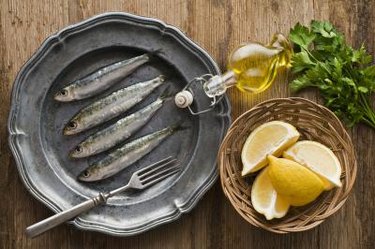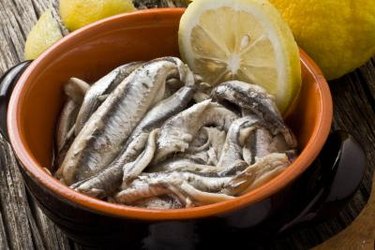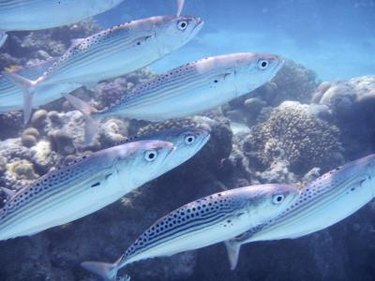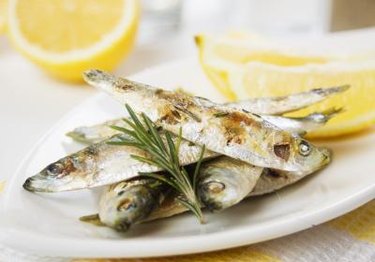
Anchovies and sardines are both small, silvery, oily fish, and they are even related. Nevertheless, they are different fish, and connoisseurs will even be able to pick out the "true" sardine or anchovy from among the rest.
Relationship
Video of the Day

Anchovies (Engraulidae) and herrings and sardines (Clupeidae) are fish families that both belong to the order Clupeiformes. Most fish in this order are silvery with stream-lined, spindle-shaped bodies, live in large shoals and eat plankton that they filter from the water with their gill rakes.
Video of the Day
Anchovies

Anchovies are found in the Atlantic, Indian and Pacific oceans, and some species enter or live in freshwater. They have translucent bodies with a silvery stripe down the flanks, and most species are less than 6 inches long. The North American anchovy is the Anchoa, but the true anchovy is the Mediterranean variety, the Engraulis, according to the Monkey Dish website. Anchovies travel in dense schools and mingle with other small fish.
Sardines

"Sardine" is the generic name for several fish, including herring, sprat and young pilchard. Sardines are small, soft-boned fish that live in saltwater and swim in huge schools. Canned sardines from the United States and Canada are Atlantic herring, while the ones from Norway are sprat, according to the Monkey Dish website.The name "sardine" is thought to originate from the catches of young pilchards off the coast of Sardinia, Italy, according to the Practically Edible website. The pilchard is the true sardine, according to the connoisseurs. Generally any "sardine" will be an average of 5 to 8 inches long.
Packaging

Most anchovies are canned or exported to be salted, smoked, pounded into paste or distilled for fish sauces. Canned anchovies are sold flat or rolled and can be very salty. Reduce saltiness by soaking the anchovies in cool water for 30 minutes, then patting dry, suggests the Monkey Dish website. Despite their name, salt-packed anchovies have the least salty flavor. They are sold whole with bones and can be cleaned by rinsing them under running water and pulling off their fins. Separate into two fillets using your finger and pull away the bone that will adhere to one of the fillets. Anchovy paste, made of pounded anchovies, vinegar, spices and water, comes in a tube for convenient use in cooking. In the United States, sardines are sold salted, smoked or canned in oil, tomato or mustard sauce. Fresh sardines are available during the summer.
Uses

Fresh anchovies and sardines are more commonly eaten in Europe. In Europe, larger sardines may be roasted in the oven or cooked on the grill whole or in fillets. Marinated fresh anchovies are available in Spanish, Greek and Italian groceries and restaurants. The strong-flavored anchovy is used in Caesar salad dressing and Worcestershire sauce, according to the Cookthink website.
Benefits

As oily fish, both sardines and anchovies have considerable health benefits. While white fish have fat or oils solely in their livers, the oils of oily fish are distributed throughout their bodies and are consumed when they are eaten. Oily fish are rich sources of omega-3 and omega-6 fatty acids, beneficial fats that can only be obtained from food sources. Omega-3 fatty acids are thought to lower blood pressure, protect against heart and circulation problems and alleviate inflammatory diseases, among other benefits, according to helpwithcooking.com.
- Monkey Dish: Anchovies and Sardines
- Practically Edible: Sardines
- Cookthink: What's the Difference Between a Sardine and an Anchovy?
- Helpwithcooking.com: Oily Fish
- BBC Wildlife Finder: Anchovies, Herrings and Allies
- Fishbase: Family Engraulidae-Anchovies
- Fishbase: Family Clupeidae-Herrings, Shads, Sardines, Menhadens